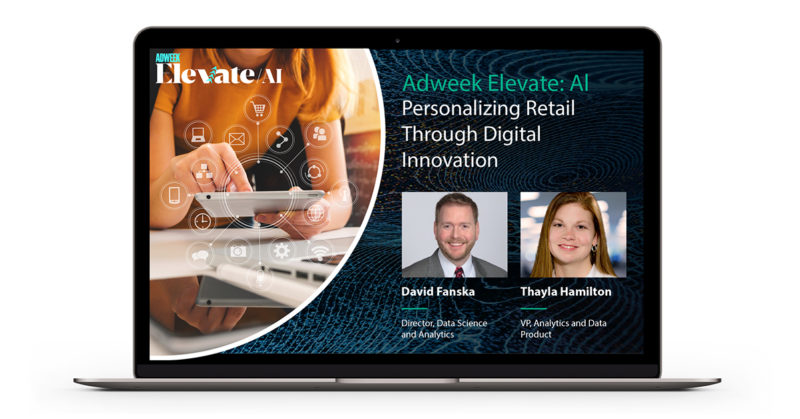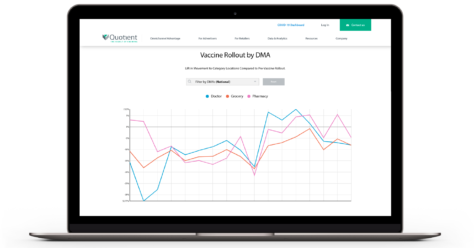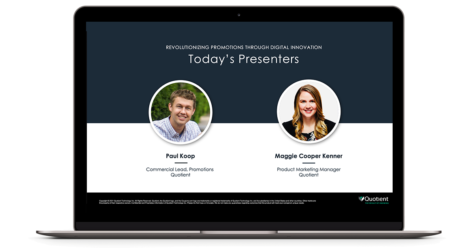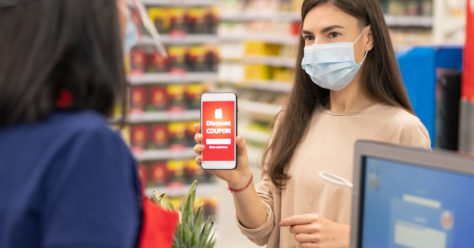Adweek Recap: Personalizing Grocery Retail Through Digital Innovation
During Adweek’s recent Elevate: AI event, Quotient’s Vice President of Data and Analytic Product, Thalya Hamilton, and Director of Analytics and Data Science, David Fanska, hosted a session to discuss personalizing grocery retail through digital innovation. During the event, they covered:
The challenges of driving innovation in a traditionally brick-and mortar industry
Common misconceptions around personalization
How retailers can use data to unlock new opportunities
Read the full session recap for their top three takeaways from the event.
Focus on Omnichannel for Cohesive Shopper Journeys
The industry has seen a disruption as a result of Covid. Under normal circumstances, consumer behavior is difficult and slow to change. However, the pandemic created a situation in which many consumers had to adopt eCommerce services as a way to avoid in-person interactions. According to Quotient Internal Data, Q1 2021 eCommerce weekly sales are 264% higher than the same period last year.
The majority of people have traditionally shopped in-store for groceries, with only certain population segments adopting delivery, click and collect and other eCommerce services—some of which have been around for a while but were not widely adopted. Retailers who were already prepared to service this huge influx of new eCommerce shoppers during the pandemic were much better positioned than their competitors, who were playing a bit of catch-up.
Today, Hamilton emphasizes that retailers need to account for a complex and not necessarily linear consumer journey. Unlike pure eCommerce businesses, many traditional grocery retailers offer their consumer the choice of online and in-store shopping. That means that consumers are able to go back and forth from eCommerce to in-store shopping and vice-versa. It’s up to retailers to make that omnichannel journey between online and offline channels as seamless and cohesive as possible for their consumers.
Earn (and Keep) Consumer Trust Through Personalization
Fanska defines different levels of personalization—a basic one being what he called a “popularity sort.” This is when marketers promote things like the highest purchased category or the most clipped offers across a retailer’s network, regardless of who’s logged in.
Other levels of personalization involve segmenting users based on general audience demographics, breaking users out by previous behavior or even asking users directly what their interests are through user-directed data like site searches or coupon clips. Fanska argues that fully personalized platforms utilize all of the above: a blend of retailer “hot offers,” geographic or demographic triggers and individualized preference—either with purchase data or intent data.
“You need to get users to opt in, inform users how you plan on using their data and ensure that your personalization provides value back to the consumer.”
It’s important to distinguish between targeting and personalization. Personalization is a platform capability while targeting is objective-driven, but personalization shouldn’t be used to target shoppers. Instead, marketers can use personalization to make sure the content is relevant and the experience is convenient. In contrast, targeting encompasses media or promotions that can be used to achieve general as well as personal objectives, such as driving brand awareness, introducing shoppers to a new brand based on product affinity or alerting shoppers to relevant promotions.

Leverage First-Party Data to Create Direct Consumer Relationships, Unlock Engagement Opportunities and Reveal New Insights
When it comes to meeting the specific needs of retailers, marketers need three key elements: comprehensive data, algorithm expertise and domain knowledge.
Data acts as the foundation on which everything is built. Algorithm expertise can involve a dedicated Analytics and Data Science team to capture and organize that data properly—executing exploratory data analyses, feature engineering and building the foundation for algorithm development to transform. Finally, domain knowledge is the linchpin that ties everything together. Marketers need to have a full understanding of the landscape in order to know how to apply data and algorithm expertise.
Data continues to be a hot topic due to the recent news surrounding cookies and tracking. According to Hamilton, third-party data once served its purpose for advertisers—but the industry is now on a path toward more permissioned marketing. Instead of targeting shoppers across the web and basing promotions and media on their web history, first-party data can offer consumers a clear and fair value exchange in the advertising ecosystem.
“Having access to first party data is vital, but also important is working with partners with the knowledge, experiences and infrastructure to intelligently leverage it.”
Large-scale logged-in environments, such as those offered by retailers, are well positioned for this industry shift. Hamilton predicts that we’ll see continued innovation around ad and promotions platforms in these environments, allowing brands and retailers to understand their customers on a higher level. Whether inspiring consumers to log into a retailer or encouraging them to sign up for a brand’s rewards program, the end result is the same: businesses will learn more about who their shoppers and what they want and need. In turn, they can deliver exactly that.






Takeaways for Retailers
Because Covid changed the way people shop, many consumers now see their experiences with brands and retailers as one journey. Marketers should plan with this in mind by enabling cohesive omnichannel experiences.
Hamilton and Faska recommend that marketers focus on intelligent personalization informed by first-party data to strengthen their relationships with consumers—proving their value and creating trust so that consumers stay opted-in. Having these direct relationships with consumers can also help retailers navigate the impending “cookie-less future.”
To learn more about Quotient’s innovative approach to personalized digital marketing, contact us at communications@quotient.com.



